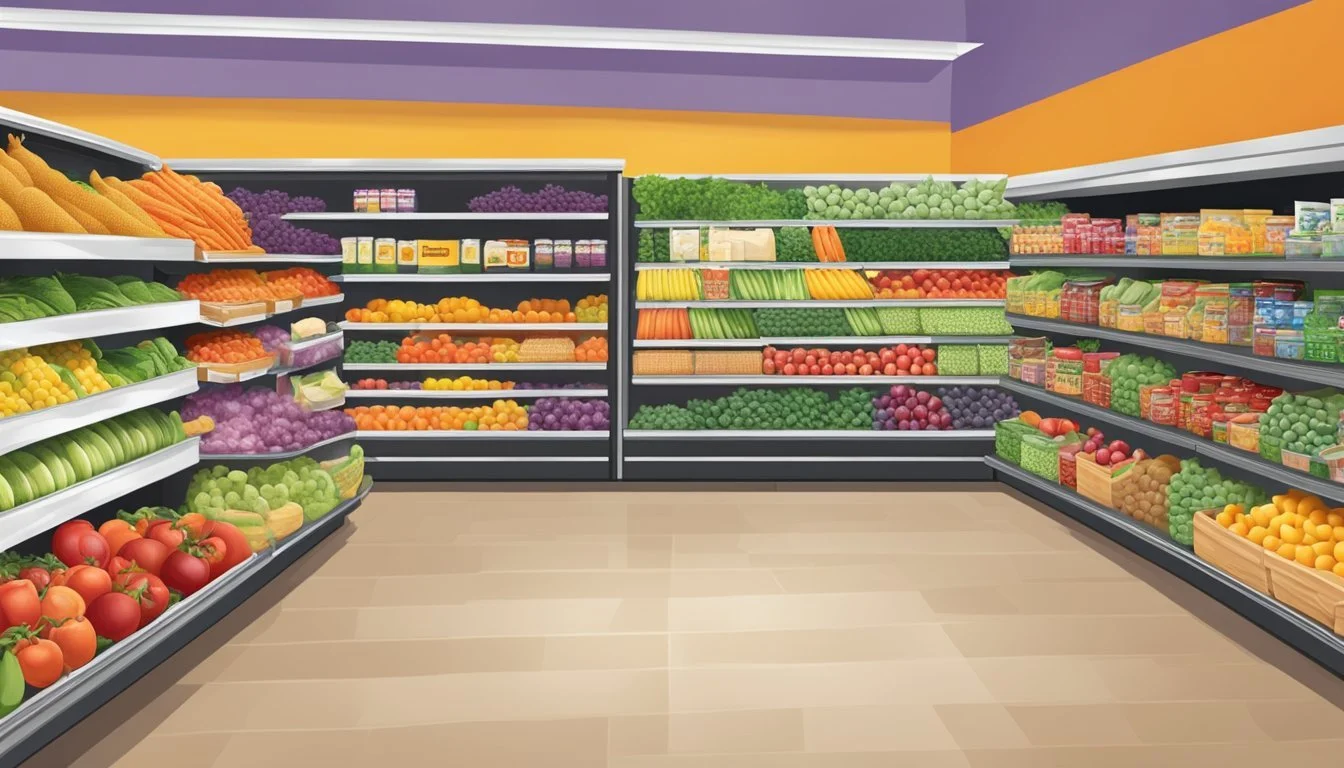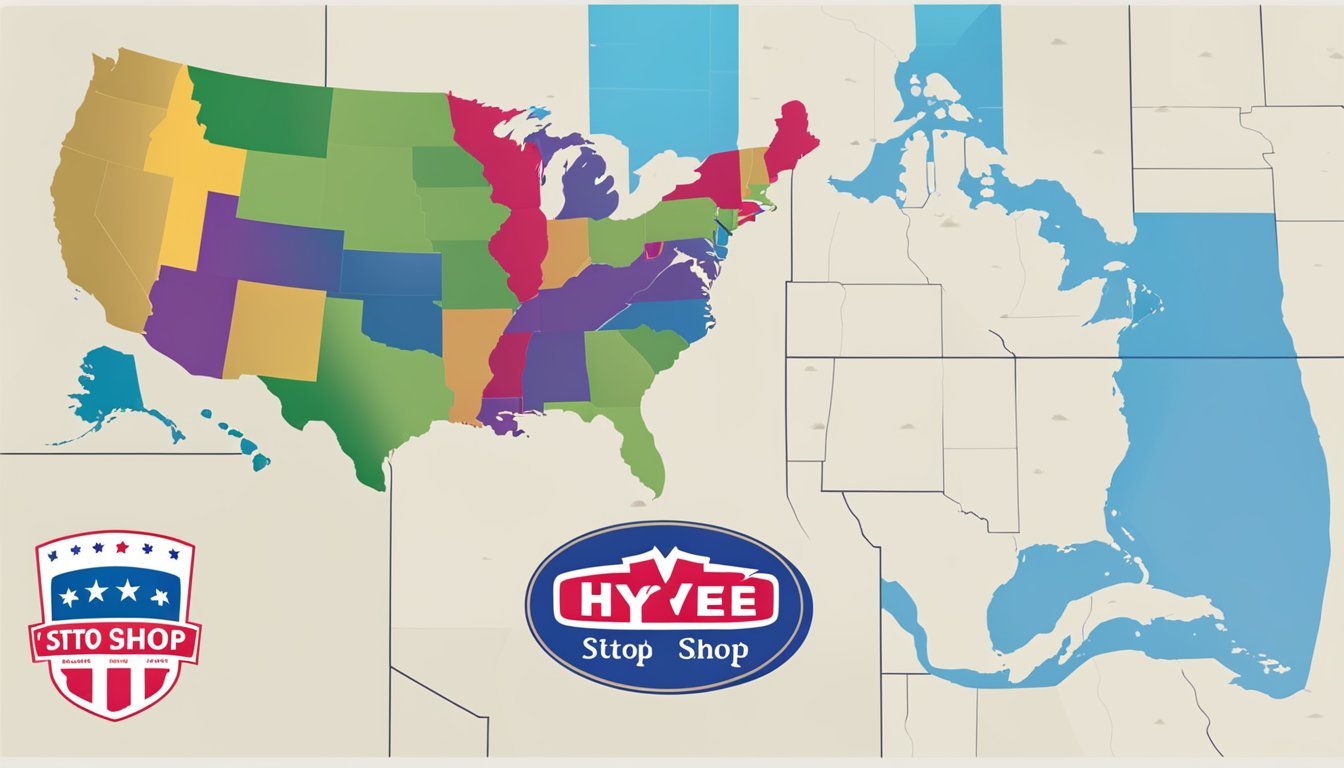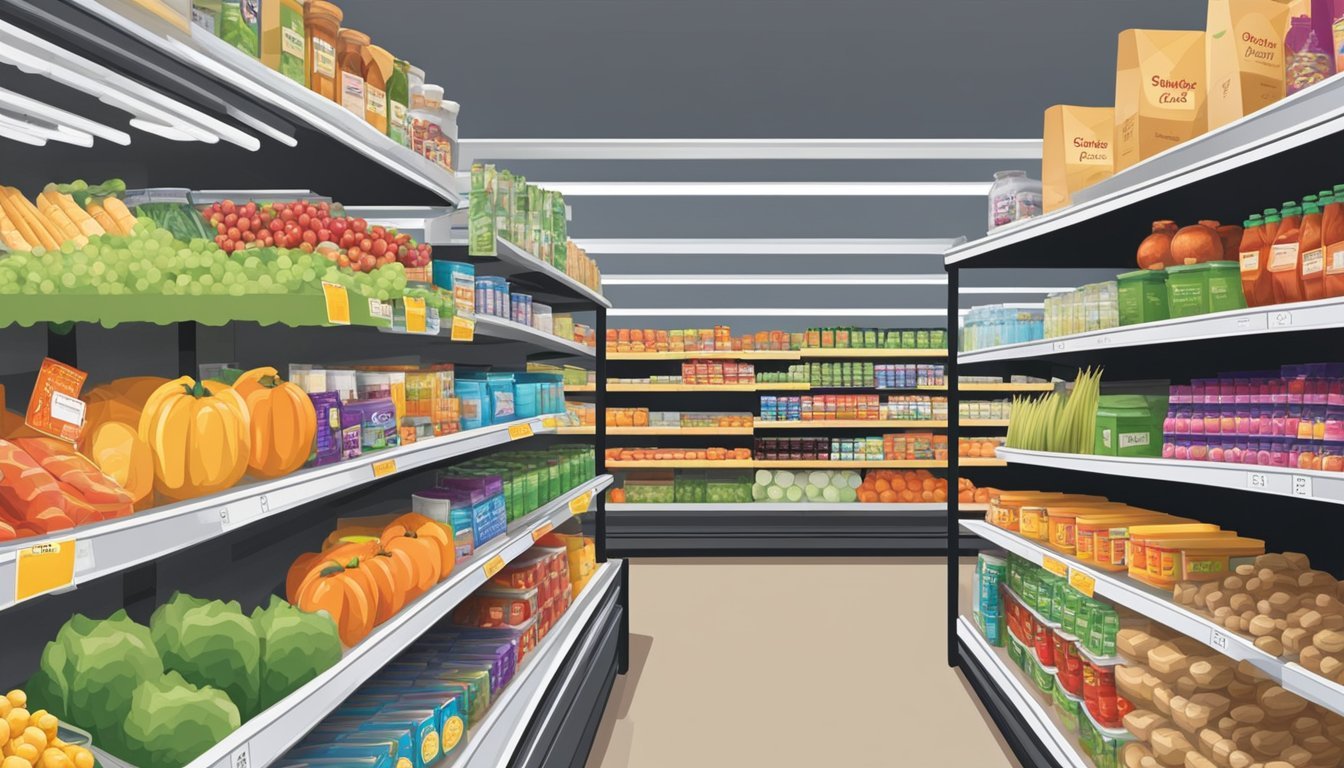Hy-Vee vs Stop & Shop
Comparing Shopping Experience, Prices, and Quality
Part of Our Grocery Store Guide with Details on Hy-Vee and Stop & Shop
When assessing the value and convenience of grocery stores, two prominent names often come up: Hy-Vee and Stop & Shop. These supermarket chains are respected throughout various regions of the United States, offering a wide range of products and services to cater to the diverse needs of their customer base. Hy-Vee, with its roots in the Midwest, has earned a reputation for quality, whereas Stop & Shop, serving the Northeast, is recognized for its longstanding presence and commitment to the communities it serves.
The debate over which store provides a better shopping experience can hinge on several factors, such as the availability of promotional deals, payment options, and overall customer satisfaction. Hy-Vee often boasts a friendly approach with innovative store formats and a strong focus on customer service. On the other hand, Stop & Shop tends to leverage its regional familiarity and consistent service, aiming to provide a reliable grocery shopping destination for its patrons.
Additionally, in a rapidly changing retail landscape, both chains have taken steps to adapt to consumer demands. For example, Hy-Vee has developed alternative store formats to keep pace with emerging shopping trends, while Stop & Shop has worked to integrate technological advances to streamline the shopping experience. Deciding which store is superior ultimately depends on the shopper's personal preferences, loyalty programs, store locations, and the specific services offered by each supermarket.
Company Overview and History
The histories of Hy-Vee and Stop & Shop trace back to humble beginnings in the American Midwest and Northeastern regions, culminating in their rise as prevalent supermarket chains. These companies have shaped the grocery landscape across the United States with deep-seated roots in their founding locations and ongoing commitment to their communities.
Hy-Vee Origins
Founded in 1930 in Beaconsfield, Iowa, Hy-Vee is an employee-owned supermarket chain widely recognized across the Midwestern and Southern United States. Charles Hyde and David Vredenburg launched the first store during a precarious economic period, just before the 1929 stock market crash. Despite such timing, their dedication to providing quality merchandise, attentive service, and affordable pricing set a solid foundation for the company. Hy-Vee's corporate office is based in West Des Moines, Iowa, upholding its Iowa origins while serving over 280 stores that showcase the classic Midwestern family values of hospitality and reliability.
Region Headquarters Type of Ownership Foundation Year Midwest & South West Des Moines, IA Employee-Owned 1930
Stop & Shop Development
Stop & Shop began its journey in 1892 as a small grocery store before evolving into the Stop & Shop Supermarket Company. Initially known as Economy Grocery Stores Corporation, Stop & Shop experienced significant milestones, including going public in 1925 and its later rebranding in 1947. With its foundations in the northeastern America, specifically the Northeast, it has expanded to a notable 406 stores across the region. Stop & Shop's steady development reflects a commitment to community and innovation within the supermarket sector, delivering a comprehensive shopping experience that emphasizes both variety and value.
Region Expansion Rebranding Year Foundation Year Northeast 406 Stores 1947 1892
Both Hy-Vee and Stop & Shop have endured through the Great Depression and other economic challenges to become mainstays in their respective regions. They have each cultivated an image of reliability, family-oriented service, and corporate responsibility through their histories and into the present.
Store Locations and Regional Presence
In comparing Hy-Vee and Stop & Shop, one must consider their store locations and the regional presence they command. The differences in location distribution significantly affect customer accessibility and brand familiarity across various U.S. regions.
Hy-Vee Store Locations
Hy-Vee is a stalwart in the Midwest with a strong presence across several states. It boasts approximately 285 stores that predominantly serve customers in areas like Iowa, where it holds a remarkable 65% share of grocery store visits. Other states with significant Hy-Vee presence include Nebraska (41% share) and South Dakota (58% share). The brand originates from West Des Moines, Iowa, and has successfully established itself as a leading grocery destination in the Midwest, exceeding expectations in both rural and urban communities.
Stop & Shop Market Reach
Stop & Shop, in contrast, has a significant presence in the Northeastern United States. The chain has effectively permeated the New England region, including securing a strong foothold in Rhode Island. With 27 locations in Rhode Island alone, Stop & Shop continues to expand since first moving into the state in 1956. The brand has not only established dominance in this specific part of the Northeast but also explores innovative retail strategies such as 'dark stores' designed exclusively for fulfilling online orders and deliveries.
Product Selection and Brands
When comparing Hy-Vee and Stop & Shop, the consumer's experience with product selection and store brands is pivotal. Each store offers a diverse range of products that cater to various dietary and lifestyle needs.
Exclusive Brands Comparison
Hy-Vee is recognized for a wide array of store brand products, including their signature HealthMarket brands which focus on health-conscious customers, offering vitamins, supplements, and natural products.
On the other hand, Stop & Shop boasts a selection of store brands such as Nature's Promise which offers organic and free-from options. It also features affordable essentials under the Guaranteed Value line.
Hy-Vee:
HealthMarket
Hy-Vee brand products
Stop & Shop:
Nature's Promise
Guaranteed Value
Product Variety and Freshness
Both retailers offer extensive produce sections, with a commitment to freshness and quality. Hy-Vee and Stop & Shop provide a seasonal selection of fruits and vegetables, ensuring a rotation that reflects fresh and locally sourced items where possible.
Hy-Vee has a reputation for its comprehensive groceries range, including a full-service deli, baked goods, and a meat department that mirrors the quality of specialized stores. The stores have been compared favorably to offerings from Whole Foods Market in terms of whole foods and specialty items.
Stop & Shop is not far behind, with an impressive array of groceries ranging from budget-friendly staples to specialty items. They offer a robust selection encompassing baked goods, fresh deli options, and quality meat products, aimed at exceeding customer expectations.
Price and Affordability
When comparing Hy-Vee and Stop & Shop, pricing and affordability are crucial considerations. Both chains offer distinct strategies for setting their prices, and employ different programs to help customers save.
Everyday Pricing Strategies
Stop & Shop operates over 400 stores in the Northeast, with a reputation for a century of service. However, its prices tend to be higher compared to some of its competitors. In contrast, Hy-Vee, with an overall score of 4.4 out of 70 ratings, competes not only on service but also on price. Comparative analysis has shown that while Stop & Shop's prices were consistently higher, Hy-Vee's pricing tends to be more competitive, especially when compared against Walmart and Aldi, known for their aggressive low-price strategies.
To provide a more comprehensive perspective on pricing:
Walmart often sets the benchmark with prices typically 12 to 30 percent lower than the average.
Aldi is recognized for its low-price model, which challenges even Walmart's prices.
Discount Programs and Savings
Both grocery stores offer various discount programs and savings opportunities. Hy-Vee has been seen to compete closely with other discounters, maintaining prices that appeal to a budget-conscious demographic. In particular, Hy-Vee employs a range of weekly deals, fuel saver programs, and digital coupons, aimed at enhancing affordability for its customers.
In comparison, while Stop & Shop offers a range of weekly promotions and loyalty card discounts, the overall impact on their higher everyday prices may be less significant. Even with these discounts, Stop & Shop is seen to maintain a pricing model that sits above the likes of Walmart and Aldi.
Shoppers looking for the most affordable options are often drawn to:
Costco, for its bulk-buying savings.
Walmart, for everyday low prices.
Aldi, for its no-frills, low-cost grocery solution.
In summary, Hy-Vee and Stop & Shop both strive to offer value, but Hy-Vee's competitive pricing strategies position it more closely to discount leaders like Walmart and Aldi.
Customer Experience and Services
When comparing Hy-Vee and Stop & Shop, customer experience and the services offered play a pivotal role. Each store has its own set of amenities designed to enhance shopping convenience and satisfaction.
In-Store Services
Hy-Vee is known for its wide array of in-store services that include a pharmacy, a bakery, and a specialty health market. The addition of medical clinics and sports nutrition centers targets health-conscious customers, providing a seamless shopping experience for those in search of wellness products.
Stop & Shop, on the other hand, offers a combination of traditional and specialized services to cater to diverse shopper needs. The presence of pharmacies and bakeries within the stores ensures that customers have access to essential services as well as fresh baked goods, rounding out their grocery shopping experience.
Customer Satisfaction Surveys
Surveys serve as a tool to gauge the quality of services and customer satisfaction. Through customer satisfaction surveys, both Hy-Vee and Stop & Shop have demonstrated a focus on improving their shoppers' experiences.
Hy-Vee places strong emphasis on creating an enjoyable in-store experience, as highlighted by its recognition among the Most Trusted Grocery Retailers in America 2023.
Stop & Shop also invests in understanding their customers' preferences, emphasizing service quality and convenience to adapt and enhance their shopping experience.
Additional Amenities and Features
When choosing between Hy-Vee and Stop & Shop, the range of amenities and technological features each grocery store offers significantly shapes the shopping experience.
Specialty Sections and Offerings
Hy-Vee stands out for its variety of store formats, including a convenience store, dollar format, and a specialty alcohol outlet. This breadth translates to a diverse shopping experience, reflecting Hy-Vee's adaptability to consumer needs. In contrast, Stop & Shop places a premium on store-prepared foods, catering to customers seeking quick, high-quality meal options without the hassle of preparation.
Technology and Shopping Experience
Both supermarket chains strive for a seamless shopping experience with the integration of advanced technologies. Hy-Vee accepts modern payment techniques like Apple Pay Later and PayPal Pay Later, illustrating its commitment to a frictionless checkout process. Stop & Shop hasn’t been explicitly mentioned to use these technologies, but it maintains a focus on ease of shopping, which likely encompasses a variety of payment options.
Market Competition and Positioning
In the competitive landscape of grocery retailing, store chains like Hy-Vee and Stop & Shop vie for market share with distinct branding and customer experiences. Understanding their positioning involves looking at their performance relative to other chains and how they adapt to industry trends.
Comparison with Other Chains
Hy-Vee, primarily located in the Midwestern United States, has carved out a niche for itself by providing a broad selection of goods and a notable commitment to customer service. It competes with regional players such as Meijer and Wegmans, both known for their quality products and positive shopping environments. Stop & Shop, having a strong presence in the Northeast, faces competition from chains like ShopRite and Market Basket, valued for their deals and regional familiarity.
Publix and Kroger dominate the Southern and Southeastern markets with their vast networks.
Albertsons and Safeway, function effectively in the West and have a loyal customer base.
Trader Joe's and Sprouts Farmers Market cater to the niche of health-conscious and environmentally-aware consumers.
The rise of Amazon in the grocery space, with its acquisition of Whole Foods, puts pressure on traditional chains to innovate their online offerings. Discounters like ALDI and WinCo offer a substantial challenge with their lower price points, forcing others to reassess their value propositions.
Industry Trends and Adaptation
To stay relevant, grocery chains must swiftly adapt to evolving industry trends. Hy-Vee, for instance, has diversified with alternative store formats including a convenience store, a dollar format, and an alcohol outlet. They recognize the need to offer more than just groceries to attract and keep customers in a changing retail world.
Stop & Shop has been leveraging technology to enhance the shopping experience, incorporating features like in-store robots and a mobile app that streamlines shopping. Both chains, along with competitors like Target and Sam's Club, have invested in online shopping and delivery services, accommodating the increased consumer demand for convenience.
Sustainability is a rising concern among consumers, with chains like Sprouts Farmers Market and Fresh Market appealing to eco-minded shoppers.
An emphasis on local and organic options has led players like Wegmans and Trader Joe's to gain a strong following.
In conclusion, Hy-Vee and Stop & Shop must continuously evolve their strategies to retain their positions in the competitive grocery industry landscape, while also staying attuned to the preferences and values of their customers.
Conclusion
When considering Hy-Vee and Stop & Shop, consumers can look at various factors to determine which supermarket may better suit their needs. According to Consumer Reports and other comparisons, price points and store brands are significant differentiators.
Hy-Vee is recognized for its considerable growth, becoming one of the largest grocery store chains in the United States. Its revenues reflect a successful business model that might correlate with customer satisfaction.
Stop & Shop provides its customers with a range of financing options like Apple Pay Later and PayPal Pay Later, which cater to the convenience of managing grocery expenses.
In terms of store brands, both supermarkets offer value for money, with Stop & Shop often featuring newsletter coupons. Consumers should also consider the quality of products, as Hy-Vee's store brands have been highlighted for comparable fidelity to national brands.
Furthermore, the list of most trusted grocery retailers may include both stores, noting reliability and trust as valuable criteria. To make an informed decision, shoppers are advised to evaluate their personal preferences, such as product selection, store layout, customer service, and loyalty programs.
Shoppers who prioritize savings on everyday items may lean towards the supermarket with lower average prices, whereas those who value a broad selection and special financing options might choose the other. Both Hy-Vee and Stop & Shop offer a compelling shopping experience, and the final choice may well depend on the individual's specific shopping preferences and priorities.








